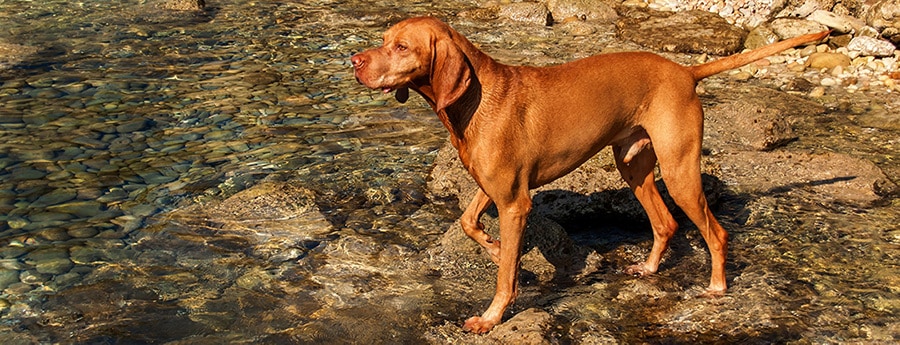
The gentle Vizsla is an exceptional hunting partner and family companion. Dignified in physical appearance, this breed is famous for its high energy levels and affectionate nature. The Vizsla is quite athletic and will eagerly engage in a variety of dog sports if given the opportunity.
Vizslas love to work and play hard during the day and then snuggle up with their family for some cuddles. Intelligence, loyalty, and love define this breed and are why they are such great all-around dogs.
Do Vizslas like to swim? Yes! Because these hunting dogs were bred to point and retrieve, the love of swimming is embedded in their genetic makeup. The extra skin between the toes, called webbing, provides more surface area and allows for navigation and speed in the water.
Taking your Vizsla for a swim is a terrific way to spend a hot summer afternoon. There are a few things you should know before you venture out though. Let’s take a quick look at why they love to swim so much and the best ways to keep them safe and healthy while they do what they love to do.
Hunting Dog Heritage
The Vizsla was bred to be a loving member of the family and a versatile hunting dog with the ability to both point and retrieve game birds and rabbits. With the tail held straight back, one front food held slightly off the ground, and muzzle pointing in the right direction, the Vizsla would indicate to the hunter exactly where game was hiding.
Having a capable dog to retrieve downed game was an incredible asset to hunters and still is. Whether on land or in the water, the Vizsla can get the job done. His heavily webbed feet were purposely bred into his ancestors to give the feet as much surface area as possible to propel them quickly through the water and to provide greater stability on land.
Start Them Early, Make It Easy, Make It Fun, Stay Safe
A puppy as young as eight weeks old can be introduced to the joys of swimming. Start off slow and easy. A kiddie pool with a couple of inches of water is just right for that first introduction. Add a toy or two to help make this a fun, positive experience, and save an actual bath for another day.
When your puppy can be trusted to obey basic commands, you can advance to slightly larger bodies of water. Enter the water with your pup and get a game of fetch going running parallel to the shore (or pool steps) in very shallow water.
As your Vizsla gains confidence, encourage him to venture out deeper either by going with him or by throwing a favorite floating toy farther and farther out with each throw. Soon, your pup will be an expert. In the beginning, keep his leash on in case he gets into trouble and always supervise.
Swimming In Large Bodies of Water
Watching a Vizsla launch himself into a picturesque lake is a beautiful sight to behold. However, lakes and other natural bodies of water do have some inherent dangers that you should be aware of. Taking proper precautions is necessary to reduce the risks and ensure your Vizsla stays safe.
- Be aware of underwater dangers. Fallen limbs, rocks, and fishing gear are often submerged and can injure your dog if he lands on them. Know if your area is home to threats such as snapping turtles and venomous snakes.
- Bring along some fresh water and offer him a drink often so that he won’t be tempted to sample the local offerings.
- Know the signs and dangers of blue-green algae. If you notice any algae floating on the surface of the water or notice that the water is olive green, greenish blue, or red, steer clear of it. A quick internet search can alert you to any algae bloom warnings in your area.
- Educate yourself about any parasites and bacteria, especially leptospirosis, that are common to your area. Keeping your Vizsla up-to-date on his vaccines will help protect against some, but not all, of the dangers. Talk with your veterinarian to learn how to further protect your dog.
- Watch out for dangerous rip currents and do not allow your Vizsla to ingest ocean water if you decide to treat him to a day at the beach.
- Bring along a few towels to thoroughly dry your wet buddy off so that he won’t lick any harmful substances off of his coat.
Be Cautious In Cold Water
While most dogs have a warm undercoat to protect them in the cold, Vizslas do not and can chill quite easily. This is why it is not a good idea to allow a Vizsla to swim in cold water. If the water is too cold for you to jump in, then it is probably too cold for your Vizsla as well.
Of course, some Vizslas just don’t care if the water is freezing cold. They are blinded to all common sense by the mere thought of going for a swim. While their enthusiasm is admirable, remember that you are responsible for their well-being and must practice some tough-love to keep them safe.
Ear Care For Vizslas
Those lovely, floppy ears that contribute to the Vizsla’s unique appearance also can contribute to ear infections. Because the ear flap keeps the ear well covered and blocks air flow, heat and moisture are trapped inside creating the perfect environment for infections to develop and thrive.
Routine ear cleaning is important, and for dogs not prone to infections, should take place about once a month. More frequent cleaning will be necessary for dogs that do tend to get infections and for dogs that swim regularly.
To clean your Vizsla’s ears:
- Gather supplies first. You’ll need gauze pads, ear cleaning solution, and a towel.
- Drip a bit of cleaner inside the ear and gently massage the base of the ear.
- Use gauze pads to carefully wipe out the ear. Repeat until no more gunk remains.
- Allow him to shake, because he will really want to.
- Clean up any mess with the towel and you are done.
Related Questions
Do Vizslas do well in colder weather?
No, these dogs lack a protective undercoat to keep them warm in cold temperatures. While some Vizslas may seem to be unaffected by the cold, they should never be allowed to stay out in freezing temperatures for long. Dog coats can purchased to keep your Vizsla warm when he does need to go outside.
Where did Vizslas originate?
Although the exact details of the Vizsla’s origin have been lost over time, there is evidence that ancestors of today’s Vizsla were living and working with the Magyar tribes in the Carpathian basin, now known as Hungary, as early as the eighth century.
That’s A Wrap!
Vizslas are naturals in the water and will delight in the opportunity to swim. They will enjoy the exercise, use up a bit of that famous energy, and have a fantastic time doing what they were bred to do.




